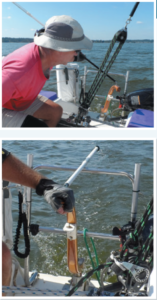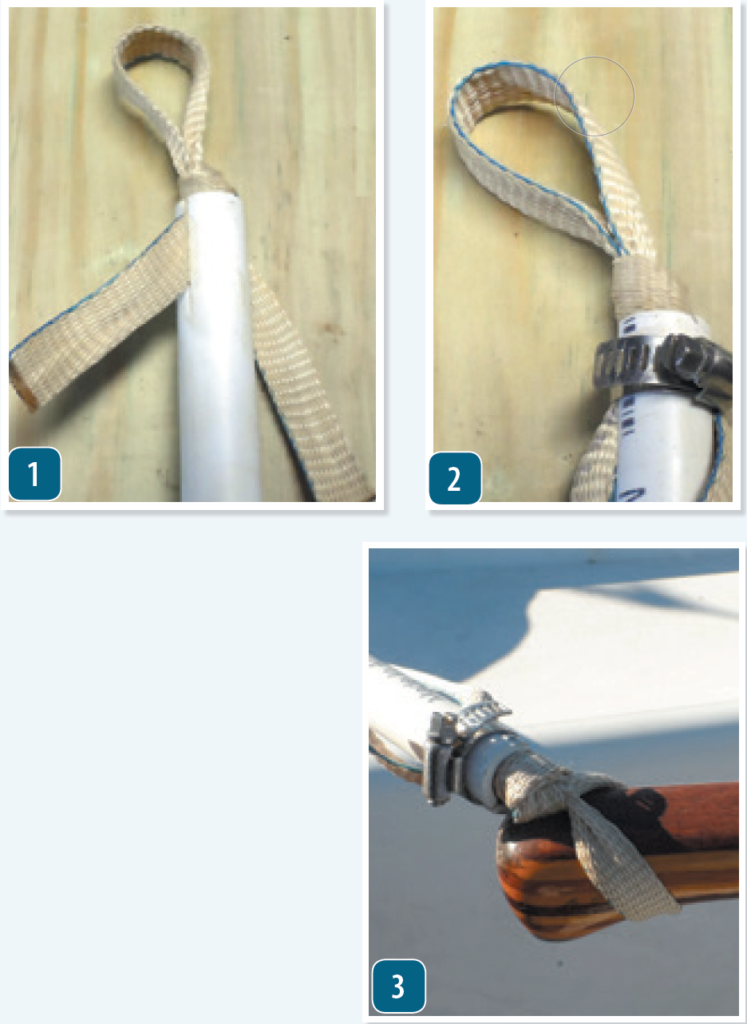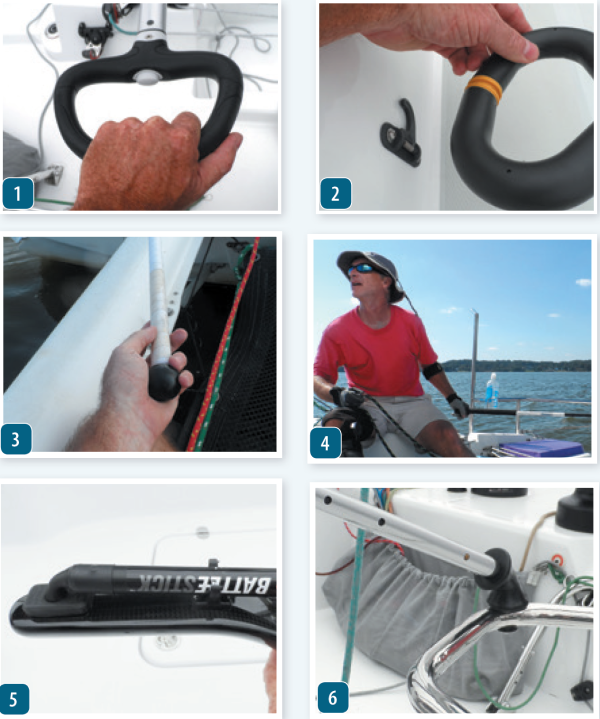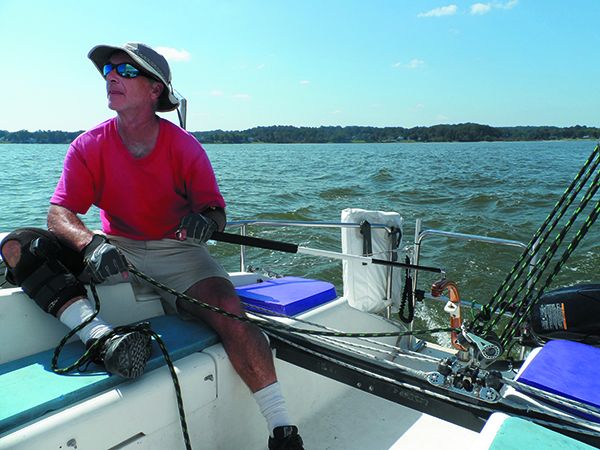Wheel steering is all the rage, even on cruising boats under 30 feet. It looks “shippy,” holds a steady course, and makes fighting weather helm less tiring. Yet just a few decades ago a wheel would have been considered inefficient on smaller boats. It adds complexity, crowds the cockpit, and isolates the helmsman from all-important helm feel, hampering efficient windward work. Tiller steering dominates racing boats up to considerable size.
A tiller is not without downsides. In anything but a mild conditions, the helmsperson usually must sit, since there’s no comfortable handhold for support while standing. Visibility can be poor, especially if there is a high cabin or dodger, and you’re limited in your ability to move around the cockpit.
Enter the tiller extension. It frees the helmsman to move about the cockpit to tend a winch or sit up on the combing for a better view. They can move their weight to windward, if that will help, or adjust their seating position to ease back pain. On lazy days they can find a spot in the shade, and what’s wrong with that?
Picking the right tiller extension is as personal as picking shoes. It is your point of contact with the rudder, and if it’s not comfortable and responsive in both light and heavy winds, sailing performance and enjoyment will suffer. Racers are known to bring their own extension, in case they dislike the one that is fitted.
Some sailors will immediately love the extension, while others might need a trial period. A few just don’t hold up, and some were never comfortable. The most glaring failures, however, always been related to having the wrong type of extender or the wrong length—not the particular brand or model. For specific product reviews, see “Tiller Extensions: Forespar’s Cobra and Spinlock’s E-Series,” September 2000.
What We Tested
During this investigation and prior PS investigations we’ve used many styles from Forespar, Harken, Ronstan, Spinlock, and a few specialty manufacturers. Styles range for the lightest dingy wands to stout D-handled keelboat extensions, and lengths from 2 feet to 8 feet.
How We Tested.
We sailed in all sorts of weather, from sultry summer days when the extension helped us move into the shade, to survival conditions when keeping the boat upright was the main challenge. We evaluated comfort, ease of use, and durability.
Choosing the Right Style
The upsides of using an extension are obvious. Increased mobility, increased comfort, a better view, and weight to windward. But there are downsides. Picking the right stick is critical to minimizing these.
There are also downsides. If the tiller is hinged, it can lift instead of turn when you tug on the extension from your perch high on the coaming. If sitting forward you may only be able to turn a small amount before the extension-to-tiller angle becomes zero and you can’t pull the rudder any farther, perhaps a very short distance if there is strong weather helm. While pulling the tiller toward you, an extension can jam against the coaming or in the stern pulpit rails, causing loss of control.
Specific to multihulls, an extension that is long enough to reach the side deck is a compromise. While it’s nice to have extra weight to windward, you’re a long way from the sail trim controls. With a full crew, staying near the sheets is less important. Shorthanded, however, the ability to quickly ease a sheet or make small tweaks may be more important than getting your weight outboard.

Using an extension adds one more element to tacking, either a nuisance or a benefit, depending on how it is handled. Like most things sailing, there is no single best way, only trends within certain geometries. For dinghies, there are many excellent boat-specific videos online. For the rest of us, there are these general rules:
Tacking
If the tiller and helmsman are in front of the traveler, start the tack holding the extension in the same hand as before the tack in a dagger grip. Facing forward, push the tiller across. As soon as the rudder is hard over, pass the extension across forward, being careful not to mow down your crew. Alternatively, you can wait until near the end of the tack, but soon after the start seems less hectic.
If the tiller and helmsman are behind the traveler, proceed as above but using a golf grip and passing the extension aft. The extension may also be passed in a more vertical position, since it may be behind the boom.
If the tiller is behind the traveler and the helmsman is in front of the traveler (common on smaller multihulls), hold the extension in the aft hand with a golf grip, face aft, passing the extension behind the mainsheet just as the tack begins, preferably before the rudder is hard over since this results in a shorter arm reach.
If the extension is long it is very helpful to hold it vertically, close behind the boom (see photo); this reduces the weight and makes for an easy pass. As you move across, switch hands and sit down on the new side. Somewhere in that process you pass the mainsheet from hand-to-hand.
Because you are reaching around the mainsheet tackle, this won’t work for jibing unless the traveler is centered and fixed. To jibe, either center the traveler, park the extension in a holder, or pass the extension before the jibe begins. You don’t want to be reaching around the mainsheet during the jibe. The best practice is generally to park the extension and use the tiller directly.
If the extension is very long (as with some trimarans) twin extensions can be used. The unused extension is typically kept in position along the rail by light bungee cords. It must be long enough not to jam on something when pulled inboard and then back out, but not so long as to drag in the water.
If it seems like there’s too much going on, park the extension during tacks and jibes.

A Place to Park
There will be times when you want to put the extension down and just steer with the tiller.
Do not simply drop the extension. Except for the lightest dinghy sticks with polymer hinges, which stand straight up when released, the extension will jam against something, locking the helm at the worst moment. Dropped overboard it will drag in the water and be difficult to recover.
Our Stiletto 27 had a cradle on the tiller cross arm where it could be rested when not in use (see photo this page). Many sailors add a boat hook clip to the top of the tiller, about 1-foot aft of the pivot, and clip it there. On our Corsair F-24, we added horns to the stern rail, providing a safe resting place for even our 8-foot extension.
Auto-pilot
There are also times when a tiller pilot or tiller lock is the better answer. A tiller extension does not allow you to move everywhere or use both hands. A tiller extension lock box, in combination with an adjustable extension, is sometimes heralded as a tiller lock and auto-pilot substitute.
In our experience, these are useful for preventing the rudder from flopping around at anchor but are not for holding course; they are just too fiddly to adjust. See “Tiller Taming with Two Fingers,” Practical Sailor, December 2014. As for tiller pilots, I’ve had Raymarine ST2000s on two boats and liked them. Renowned West Coast sailor Skip Allan reported on these in the June 2009 issue of Practical Sailor.

Dagger vs. Golf Grip
You can grasp the extension either as a dagger (palm under the extension) or as a golf club (fingers under the extension). Both approaches have adherents and often the choice depends on the boat. Each require learning certain habits.
- Dagger grip. This grip is helpful if you sit well aft, for small boats, and if the coaming is high. The cross-chest motion is extremely responsive and the butt of the extension won’t jam against the coaming. The neutral wrist position is comfortable.
- Golf grip. This is grip good for beach cats because it is more comfortable with long extensions. It works well on boats without coamings or seat backs, where it can rest on the seat. It is handy when moving farther forward, since it keeps the direction of pull at a greater angle to the tiller. Your wrist is constantly flexed, which can be irritating if you have wrist or hand problems.
Sometimes making your own extension is the best solution to steering challenges on tiller-steered boats.
The steering arm can be solid wood, or tubing—usually aluminum or carbon fiber. The hinges are available from many sources. Your main decision is whether you want the extension to be easily removable.
If you just want an over-the-counter version, then refer to the Value Guide on page 18 for our ratings. If you are not sure what you want, the normal response is, “I’ll get an adjustable extension.”
However, most of the extensions you see on race boats or larger boats are fixed length. It is no mystery why. They are lighter than adjustable extensions, smooth to handle, harder to break, and won’t slip under high load.
You can choke up when you need a shorter length. Even if you decide that an adjustable extension might be the best answer to satisfy the whole crew—you still need to determine the right length. And that is when a mock up tiller handle comes in handy.
MAKING A MOCKUP TILLER EXTENDER
This mock-up is not intended for extended sailing use. It is only for a light wind trial, to help determine what length and style will work best, and perhaps to decide if adjustable or fixed length will suit you best.
- Start with a 15-inch length of 1/2-inch webbing and form a loop that fits snugly over your tiller. To form the loop a simple overhand, or figure-eight knot works well. You want everything snug, but you also want to allow enough space between the pipe and the tiller to create a free-moving swivel (see photo 3).
- Slot the ½-inch PVC pipe with a hand saw about ¾ inch deep on both sides.
- Slide the webbing tails through the slots (see photos 1 and 2), lay them down the sides of the pipe, and use a hose clamp to squeeze the slots closed on the webbing. A second clamp backs it up. Cover the hose clamps with athletic tape to prevent scratching.
- Slide the webbing loop onto the tiller and tape it in place with 1½-inch athletic tape (see photo 3). The webbing will stretch for a snug fit.
- Cut the extension to the proposed length, leaving it a little long to start.
- If you cut off too much, it can be added back using either glued couplings (fixed) or threaded adapters (to simulate an adjustable extension).

A mock-up is just a fitting aid, not a DIY option. It will be floppy and heavy, to the point of convincing you to do without an extension, but stick with it. Try a number of seating positions, postures, and grip styles (dagger vs. golf). The coaming offers good visibility ahead, but will need padding if you want to sit there for long. Is your back in a weird twist? How’s the wrist holding up? Try multiple position grips and seating positions, since the best choice will change with the weather. Be fussy and get it right.

Try a few tacks and jibes to learn how it swings when you pass the extension. You may find that when it blows you like to sit down in the cockpit, fist on the tiller. Our F-24 trimaran requires two extensions to cover the enormous range of requirements— a 4–foot extension for cockpit and coaming use, and a 10-foot length when sitting on the ama (see photos above). Fortunately, our stern rail rest supports them both “Tacking and Self-steering with a Tiller Extension”).
Is the tiller forward or aft of the mainsheet? If aft, very long extensions can be passed behind the mainsheet. If forward of the mainsheet the length is constrained by what you can pass between the end of the tiller and the mast or cabin, and how many crewmate heads you are willing to smack. That’s an exaggeration, of course, but it is a factor.

Duckworks, www.duckworks.com
■ Racelite Tiller Extension (part# RL494)
www.duckworksbbs.com/product-p/rl-494.htm,
■ Ronstan Universal Tiller Extension Joint (part# RF3133)
www.duckworksbbs.com/product-p/rf3133.htm
Murrays sports, www.murrays.com
■ Hobie Tiller Yoke (SKU# 01-0062)
www.murrays.com/product/01-0062
Ronstan,www.ronstan.com
■ Ronstan Tiller extension hardware (multiple parts)
www.ronstan.com/marine/range.asp?RnID=075
Forespar, www.forespar.com
■ Spinlock TFP Quick Release (part# 104004)
www.forespar.com/products/tiller-extension-twist-lock.shtml.
Spinlock, www.spinlock.co.uk,
■ Spinlock Spinflex Joint (SPEJB-KIT)
www.adventurehardware.com.au/tiller-extensions/tiller-
extension-spares/spinlock-spinflex-joint-for-ejb-600-and-900-
tiller-extensions/
Carbon Fiber Tube Shop, (tubes of various sizes),
www.carbonfibertubeshop.com

Handle design
- Straight pole. A golf-style grip works well with a simple stick extension. It’s easy to choke up. You can also use a dagger grip.
- Ball-end. The ball is easy to grip and improves ergonomics of the dagger grip by providing a pivot point. Proper length is critical to comfort and efficiency.
- D-handle. Because the extension rotates, you can use the same grip and motion as you would holding a tiller; these are found primarily on larger boats and when the cockpit is too wide to grip the tiller directly. These are only for small boats that are hard to steer or for boats over 27 feet.
Some folks keep several extensions onboard and switch to a golf or dagger grip in lighter winds. Before deciding which style is best, determine whether your boat has an easily balanced helm or whether it has a heavy helm that requires more force to steer.
- Grip Size. We like skinny tubes for dagger grips and fat carbon poles for long extensions that will be held with a golf grip at multiple points (common on multihulls). Athletic tape is good for renewing a slippery grip, but it will need to be re-wrapped every so often.
Attachment hardware
To attach the extension to the tiller, we like the polymer ball-joint type for dinghies and sport boats up to about 24 feet. Both Ronstan and Forespar offer this type, and both provide an excellent feel.
However, expect to replace the joint every few years, depending on sun exposure and use. These polymer joints are not the best choice if the extension will be left in place. They also are not a good choice for larger boats.
The Spinlock Diablo is a stronger version for larger boats. The tiller is not as comfortable to hold directly when the polymer couplings are removed, since the receptacle that remains on the tiller is sharp and lumpy.
When released, the Diablo has a joint that allows it to stand vertically, so there’s no need to tend the extension at all times. However, after about a year in the weather, the extension will no longer stand up straight, nor will it clip down as easily. We’d reserve these for boats that always use an extension.
Metal hinges have the clear edge in strength and durability in the sun. You can leave these installed on the tiller. If you do, you can extend the life of the grip by covering it with a Sunbrella sleeve.
An inexpensive hinge, such as the Racelite swivel, can be used as the basis of a very functional DIY extension. We’ve used this and variations for many years.
We like the flush-mount Forespar TFP Quick Release for boats that don’t always use a the tiller extension. When you remove it, the tiller is essentially free of any obtrusive hardware and is still comfortable in the hand.
The Tube
A carbon or fixed-length stick is preferred if the extension might be stepped on. Adjustable aluminum extensions jam at the slightest kink or dent. Most important, be certain the adjustment won’t slip during a high-force steering adjustment.
We liked all the straight-tube extensions we tested, but have a practical preference for metal hinges for cruising or racing boats and for polymer hinges for dinghies. We like the Ronstan TFP on our F-24 and Murray Sports’ Hobie hinge on beach cats. The Spinlock EA is a good choice for on heavier boats, and the Harken Battlesticks are a great match for smaller boats.
The polymer joint on the Spinlock is pre-molded to rest at a 30-degree angle. This means that although it won’t stand completely vertically, it will lie down more easily in the clips.

For most sailors, one tiller extension is enough, but for some racers, the best extension can vary by arm length.
- The Spinlock EA D-grip is a favorite among racers. The swiveling grip allows the hand to rotate for best comfort. The the grip and action are similar to holding the tiller directly.
- A folding hook fits into a slot in the Spinlock EA D-grip tiller extension. This can help keep the rudder locked at anchor, or keep the helm steady when the helm is balanced and the boat will hold a course on its own.
- Athletic tape (renewed frequently) is an inexpensive way to ensure a positive grip. Racquet tape also works.
- To steer comfortably with a dagger grip, you might have to move to the outer rail.
- The Ronstan Battlestick with its flexible rubber hinge and universal-type joint is a great match for smaller boats. In this photo, it is “parked” on a clip on a carbon-fiber tiller.
- The Spinlock Diablo Universal joint allows a positive connection with the tiller, and easily swivels through 360 degrees on multiple planes. The spring-loaded pins adjustments are more secure that twist-lock.

D-Handle
All the D-lock designs are pin-lock. Because the handle rotates, a twistlock is impractical. On the good side, pin-locks are more secure under high load.
The pin lock adjustment on the Forespar Ocean Racer is activated by squeezing two handles together. It’s available with a quick release or Forespar’s “StaFast” attachment.
The adjustment on the Spinlock EA is triggered by a button, requiring a second hand to release but resulting in a lighter, cleaner design than the Forespar pinch system; both had fans among our testers.
Tiller Extensions
| BRAND | MODEL | TEST STATUS | TUBE MATERIAL | END | SWIVEL TYPE | ADJUSTMENT | LENGTH | PRICE |
|---|---|---|---|---|---|---|---|---|
| FORESPAR | Twist Lock | Tested | Aluminum | Ball | Universal | Twist | 19-32 in. | 90 |
| FORESPAR | Twist Lock | Tested | Aluminum | Ball | Universal | Twist | 27-48 in. | 105 |
| FORESPAR | Fixed length | Not tested | Aluminum | Ball or golf | Universal | Fixed | 24 in. | 50 |
| FORESPAR | Fixed length | Tested | Aluminum | Ball or golf | Universal | Fixed | 36 in. | 54 |
| FORESPAR | Giant stick | Not tested | Carbon | Ball or golf | Universal | Fixed | 36 in. | 70 |
| FORESPAR | Giant stick | Not tested | Carbon | Golf | Universal | Fixed | 72 in. | 150 |
| FORESPAR | Giant stick | Tested | Carbon | Golf | Polymer | Twist | 50-85 in. | 180 |
| HARKEN | Tiller extension | Not tested | Aluminum | Golf | Universal | Fixed | 33 in. | 53 |
| HARKEN | Tiller extension | Not tested | Aluminum | Golf | Universal | Fixed | 41 in. | 56 |
| RONSTAN | Battle Stick | Tested | Carbon | Ball or golf | Polymer | Fixed | 33 in. | 92 |
| RONSTAN | Battle Stick | Tested | Carbon | Ball or golf | Polymer | Fixed | 41 in. | 96 |
| RONSTAN | Battle Stick | Tested | Carbon | Ball or golf | Polymer | Fixed | 98 in. | 140 |
| SPINLOCK | EBJ | Not tested | Aluminum | Golf | Polymer | Pin lock | 24 in. | 43 |
| SPINLOCK | EBJ | Tested | Aluminum | Golf | Polymer | Pin lock | 36 in. | 50 |
| SPINLOCK | EJ | Not tested | Aluminum | Golf | Universal or polymer | Pin lock | 24-36 in. | 205 |
| MURRAYS SPORTS $ | Tiller Extension | Not tested | Aluminum | Golf | Universal | NA | 50-95 in. | 65 |
| NACRA | Tiller Extension | Tested | Carbon | Ball | Universal | Twist | 60-107 in. | 270 |
| D HANDLE | ||||||||
| FORESPAR | Ocean racer | Tested | Aluminum | D-handle | Universal | Pin lock | 31-41 in. | 205 |
| FORESPAR | Ocean racer | Not tested | Carbon | D-handle | Universal | Pin lock | 31-41 in. | 220 |
| SPINLOCK | EA | Tested | Aluminum | D-handle | Universal or polymer | Pin lock | 24-36 in. | 205 |
| DIY HARDWARE | ||||||||
| FORESPAR | TFP | Tested | NA | NA | Universal | AKA "quick release" | NA | 75 |
| RONSTAN | RF1121 | Not tested | NA | NA | Universal | Bolt-through | NA | 37 |
| RONSTAN $ | RF3133 | Tested | NA | NA | Polymer | Battle Stick style | NA | 14 |
| RACELITE $ | Swivel | Not tested | NA | NA | Universal | NA | NA | 11.56 |
| HOBIE $ | Yoke Connector | Tested | NA | NA | Universal | NA | NA | 15 |
Conclusion
Tiller extensions are a personal choice. It has to feel right in your hand, provide good feedback, and deliver powerful steering adjustments when needed. It must be the correct length and be easily passed from one side to the other when tacking. It must be capable of delivering adequate force without being too heavy, offer great sensitivity in light wind, and withstand getting sat on without kinking. It’s a tall order to fill. No wonder we’re still looking for that ideal stick that provides perfect control and improved comfort.
Technical Editor Drew Frye is the author of “Rigging Modern Anchors.” He blogs at www.blogspot/sail-delmarva.com








































How is it that the recent “WayPoints” email has this title on its front page:
“The Many Faces of Tiller Extensions”
followed by the paragraph below and further same-context paragraphs?
“Chips and scrapes in a carefully painted mast start out as a cosmetic issue. But as moisture intrudes and corrosion takes over the paint blisters and hard metal becomes powdery aluminum oxide. Left unattended, especially in damp, salty areas, such as in the bilge or underneath mast hardware, this corrosion process can destroy metal and impair the integrity of the spar.”
Once again there is some disconnect in proofing an article.